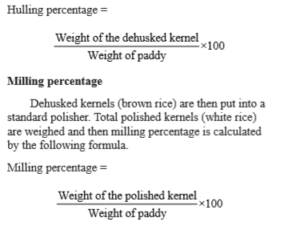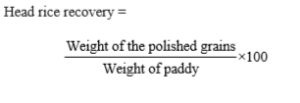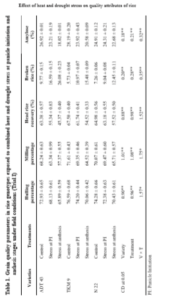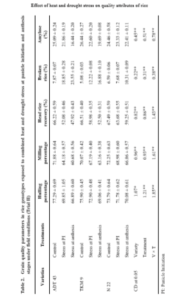COMBINED EFFECT OF HEAT AND DROUGHT STRESS ON GRAIN QUALITY ATTRIBUTES OF RICE (Oryza sativa L.) GENOTYPES
0 Views
A.R. NIRMAL KUMAR*, C. VIJAYALAKSHMI AND D. VIJAYALAKSHMI
Department of Crop Physiology, TNAU, Coimbatore, TN 641 003
ABSTRACT
The effect of short term natural high temperatures above 35oC and drought in the range of – 50 to – 70 kPa was assessed on grain quality parameters in three rice cultivars (ADT 43, TKM 9 and N 22). Drought stress coupled with natural high temperature was imposed at two critical phenophases i.e., at panicle initiation (PI) and anthesis stages under rain out shelter facility. Rice quality is determined both genetically and environmentally where, heat and drought stress caused reduction in quality characters like, Head Rice Recovery (HRR) and amylose content. The HRR was reduced when it is subjected to combined heat and drought stress whereas, broken rice was significantly increased. N 22 produced the grains with high amylose content whereas, susceptible genotype ADT 43 recorded lowest amylose content.
KEYWORDS:
Amylose, Drought, Heat, Oryza sativa, quality
INTRODUCTION
Heat stress combined with drought, is one of the major limitations to food production worldwide. As the world population continues to grow, and water resources for the crop production decline and temperature increases, the development of heat and drought tolerant cultivars is an issue of global concern. Nearly half of the world’s population depends on rice and an increase in rice production by 0.6 – 0.9 per cent annually until 2050 is needed to meet the demand (Carriger and Vallee, 2007). As a result, rice (Oryza sativa L.) is increasingly cultivated in more marginal environments that experience warmer temperatures where day/night temperatures average 28/ 22°C (Prasad et al., 2006). In these environments, day temperatures frequently exceed the critical temperature of 33°C for seed set, resulting in spikelet sterility and reduced yield. Hence, in the future, rice will be grown in much warmer with a greater likelihood of high temperatures coinciding with heat sensitive processes during the reproductive stage.
Although rice has been used as a model plant for many years, the responses of rice genotypes to combined high temperature and drought is still poorly understood. Rice responses to high temperature differ according to the developmental stage, with the highest sensitivity recorded at the reproductive stage. Temperatures more than 35°C at anthesis and lasting for more than one hour can lead to high sterility in rice (Jagadish et al., 2007). High temperature stress induced increase in spikelet sterility was attributed to abnormal anther dehiscence, impaired pollination and pollen germination (Jagadish et al., 2010). Moreover, high temperature of 39 0C given a day before flowering resulted in poor anther dehiscence during subsequent anthesis.
Increase in the average daily temperature during grain filling of rice has a detrimental effect on at least three components of grain quality i.e., enhanced chalkiness, lower amylose content, and modified cooking quality (high gelatinization temperature). High temperature shortens the grain filling because enzymes involved in starch synthesis are sensitive to high temperatures. High night time temperature also reduces the milled produce, which is the yield of whole grains (head rice) after the milling process (Counce et al., 2005).
Impacts of climate change demands adjustments in our rice production methods and development of new rice strains that can withstand higher temperatures, growing multiple stress tolerant varieties that can integrate in future climate change situations. The simultaneous occurrence of multiple abiotic stresses rather than one particular stress is commonly noticed under field conditions (Mittler, 2006). The combination of high temperature and water stress represents an excellent example of multiple abiotic stresses occurring concomitantly in the field. But, relatively little information is available with reference to combined high temperature and water stress in general and at the most sensitive flowering stage in particular in rice. Experiments were therefore carried out with the objective to study the grain quality aspects of rice genotypes under combined heat and drought stress.
MATERIALS AND METHODS
Three rice (Oryza sativa L.) genotypes namely ADT43, TKM9 and Nagina 22 (N22) which are differed in their tolerance behaviour to heat and drought stress but had similar phenology were taken for the study.
Nursery was raised at Paddy Breeding Station of Tamil Nadu Agricultural University, Coimbatore. Twentyone days old seedlings and one seedling per hill were transplanted with a spacing of 20 cm x10 cm in the Rain Out Shelter (ROS) facility of the department of Crop Physiology. Stress treatments were imposed in the ROS, while a similar area of control was maintained adjacent to the ROS facility. The dimensions of the Rain Out Shelter and the Control were 21 m long and 6 m wide. Prior to transplanting the land inside ROS and the area which is parallel outside the ROS (Control) were puddled, levelled and incorporated with recommended dosage of basal fertilizer 150:50:50 N, P2O5, K2O kg ha-1. The land was divided into 12 plots with each plot measuring 2 m2. The experiment was conducted in FRBD comprised of three treatments three varieties and four replications. The treatment details were as follows T1 – (Control) wellwatered throughout the crop growth period T2 – Drought and natural high temperature stress at Panicle Initiation (PI) stage in which water was withheld for 2 weeks with a moisture stress of -50 to -70 kpa and the temperature ranged from 34.2 to 37.8oC at the time of panicle initiation, T3 – Drought and natural high temperature stress at anthesis stage in which water was withheld for 2 weeks with soil water tension of -50 to -70 kpa and the temperature ranged from 33.5 to 36.6 oC at the time of anthesis.
Two trials were conducted (Trial – I: January, 2013 to May, 2013; Trial – II: June, 2013 – October, 2013). The time of sowing in the selected genotypes were staggered such that their PI and anthesis stages coincided the natural high temperature around early April for panicle initiation stage stress and May to June for anthesis stage stress. Temperature for the entire experiment period was monitored by installing the log stick data logger (Model. LS350-TH Japan) and an automated weather station inside the ROS and control area. Drought stress treatments were administrated and monitored by measuring the soil water potential using the tensiometers installed at 30cm depth in each plot. Water was completely withheld for 2 weeks during the stress period. Plants were re-watered when the tensiometers registered soil water tension of 50 to -70kpa.
Quality parameters
Hulling percentage
Desired amount of paddy is taken (minimum hundred grams) and subjected to dehusking in a standard dehusker. After cleaning, the dehusked kernels (brown rice) are weighed and hulling percentage is determined

Head Rice Recovery
Depending on the size of the grains the polished kernels are then passed through rice grader having different (mm) grooves. Then the whole grains are separated from the broken grains in order to quantify the head rice recovery. The percentage of the head rice recovery and broken grains are calculated as per the following formula.



Amylose content (AC)
The simplified procedure of Juliano (1971) detailed as under was used for estimation of AC. Twenty whole milled rice kernels were ground in an Udy cyclone mill (sieve mesh size 60), 100 mg of rice powder taken in a 100 mL volumetric flask was added with 1ml of 95% ethanol and 9 ml of 1 M NaOH. The content was heated over a boiling water bath to gelatinize the starch. After cooling for one hour distilled water was added and the contents were thoroughly mixed. For each set of samples run, standard varieties with low, intermediate and high amylose were included to serve as checks. 5 ml of the starch solution was taken in a 100 ml volumetric flask. One ml of 1 M acetic acid and 2 ml of iodine solution (0.2 g iodine and 2.0 g potassium iodide in 100 ml aqueous solution) were added and the volume was made up with distilled water. The contents were shaken well and left to stand still for 20 min. Absorbance of the solution was measured at 620 nm with a spectrophotometer. The AC was determined by using a conversion factor and the results were expressed on a dry weight basis. Moisture content of the samples was not determined as the relative humidity and temperature of the laboratory was controlled. For making standard curve, 40 mg of potato amylose (Sigma Chemical Co. or Stein Hall Co., Inc.) of known moisture content was wetted with 1 ml of ethanol and 9 ml of 1 M NaOH, heated for 5-10 minutes over a boiling water bath, cooled, and made up to100 ml with distilled water. Solution (1, 2, 3, 4, 5 ml) was placed with a pipette in 100 ml volumetric flasks. The solution was acidified with 1 M acetic acid (0.2, 0.4, 0.6, 0.8, and 1.0 ml respectively) and treated as above. The absorbance values were plotted at 620 nm against the concentration of anhydrous amylose (mg) and the conversion factor was determined. The dilution factor of 20 for the samples was included in the conversion factor.
Statistical analysis
Factorial Randomized Block Design (FRBD) analysis was carried out on various parameters as per the procedure suggested by Gomez and Gomez (1984). Wherever the treatment differences are found significant, critical differences were worked out at five per cent probability level and the values with respective standard errors of means are furnished. Correlation analysis was carried out by using SPSS (Statistical Package for Social Sciences) soft ware.
RESULTS AND DISCUSSION
Hulling percentage was found to be decreasing under combined heat and drought stress. A significant difference was observed among the genotypes and treatments. Both the trial data showed that plants exposed to stresses during anthesis were most affected and recorded less hulling per cent. During the first trial (trial I), ADT 43 has recorded low hulling values (68.13 and 65.89) and TKM 9 recorded the highest (74.20 and 70.6) hulling values when it is exposed to stress at PI and anthesis stages. Similar trend was followed during second trial (trial II), where ADT 43 recorded 69.85 and 66.89 at Pi and anthesis stages respectively and TKM 9 recorded the highest value (72.90) when exposed to stress at PI. While, the genotype N 22 recorded the highest (70.08) at anthesis. Rice quality is determined by both genetically and environmentally where, heat and drought stress causes reduction in yield and quality of rice (Pandey et al., 2014). Heat and drought stress promotes the remobilization of stored carbon reserves and stress during grain filling enhances plant senescence and accelerated grain filling thereby reduces grain quality.
The recovery of milled rice after polishing was higher in control over the stress treatments. During trial I, higher milling recovery percentage was observed in N 22 (69.47 and 65.71) and ADT 43 has recorded the least (63.36 and 57.37) at PI and anthesis stresses. Similarly, during trial II the genotype ADT 43 has shown the least (64.18 and 60.68) and the genotype N 22 recorded the highest values (68.90 and 66.06) at PI and anthesis stresses. Both the trial data showed that plants exposed to stress during anthesis were most affected. The quantity of total milled rice and percentage head rice that can be produced from a unit of rough rice determine the milling quality. Shrivastava et al. (2012) reported 11.0 % reduction in milling percentage when it is exposed to heat and drought stress at flowering.
The head rice recovery also followed a similar pattern of milling recovery. Combined effect of heat and drought had a significant influence on HRR. In both the trials stress imposed during the anthesis showed reduced recovery percentage. ADT 43 showed a low HRR of 55.34

and 45.37 in the trial I and 52.08 and 47.92 in trial II at PI and anthesis stages respectively. The genotype N 22 recorded the highest HRR of 63.18 and 57.52 in the trial 1 and 63.68 and 59.25 in the trial 2 at PI and anthesis stages respectively. Stress treatments had a greater influence on broken rice (Table 1 and 2). Treatments imposed at anthesis were found to have more values. In both the trials among the genotypes, ADT 43 showed higher BR % of 16.59 and 26.08 in trial 1 and 18.85 and 23.55 in trial II. The genotype N 22 recorded the least BR % of 9.04 and 12.45 in the 1st trial and 7.68 and 10.31 in the trial II at PI and anthesis stresses respectively.
All the three cultivars differed for amylose content significantly in control and combined stresses of heat and drought (Table 1 and 2). In both the trials, N 22 produced the seed with high amylose content of 24.91, 24.31 and 22.68 in the trial I and 24.46, 23.33 and 22.41 in trial II in control, PI and anthesis treatments respectively. This was followed by TKM 9 (28.19, 23.92 and 20.58) and (26.44, 22.60 and 19.69) in control, PI and anthesis treatments respectively. A significant reduction in amylose content was observed in ADT 43 (26.92, 23.21 and 18.02) and (25.09, 21.86 and 16.44) in control, PI and anthesis treatments.
Rice quality is determined both genetically and environmentally where, heat and drought stress causes reduction in yield and quality of rice. Variety ADT 43 recorded lowest and TKM 9 recorded highest hulling percentage whereas, N 22 produced the grains with high amylose content whereas, susceptible genotype ADT 43 recorded lowest amylose content. The genotype N 22 has emerged as an ideal donor with superior grain quality for the future breeding programme to develop heat and drought stress tolerance in rice.
LITERATURE CITED
Carriger, S and Vallee, D. 2007. More crop per drop. Rice Today. 6: 10-13.
Counce, P.A., Bryant, R.J.C., Bergman, J., Bautista, R.C., Wang, Y.J Siebenmorgen, T.J.K. Moldenhauer, A.K and Meullenet, J.F.C. 2005. Rice milling quality, grain dimensions, and starch branching as affected by high night temperatures. Cereal Chemistry. 82: 645-648.
Gomez, K.A and Gomez, A.A. 1984. Statistical procedures for agricultural research. (2nd Ed.) John Wiley and sons, NewYork, USA.
Jagadish, S.V.K., Craufurd, P.Q and Wheeler, T.R. 2007. High temperature stress and spikelet fertility in rice (Oryza sativa L.). Journal of Experimental Botany. 58: 1627–1635.
Jagadish, S.V.K., Muthurajan, R., Oane, R., Wheeler, T.R., Heuer, S., Bennett, J. and Craufurd, P.Q. 2010. Physiological and proteomic approaches to address heat tolerance during anthesis in rice (Oryza sativa L.). Journal of Experimental Botany. 61: 143–156.
Juliano, B.O. 1971. A simplified assay for milled rice amylose. Cereal Science Today, 12: 334-360
Mittler, R. 2006. Abiotic stress, the field environment and stress combination. Trends in Plant Science. 11: 15–19.
Pandey, A., Kumar, A Pande, D.S and Thongbam, P.D. 2014. Rice quality under water stress. Indian Journal of Advanced Plant Research. 1(2): 23-26.
Prasad, P.V.V., Boote, K.J., Allen, L.H., Sheehy, J.E and Thomas, J.M.G. 2006. Species, ecotype and cultivar differences in spikelet fertility and harvest index of rice in response to high temperature stress. Field Crops Research. 95: 398–411.
Shrivastava, P., Ritu R., Saxena, Xalxo, M.S and Verulkar, S.B. 2012. Effect of High Temperature at Different Growth Stages on Rice Yield and Grain Quality Traits 42. Journal of Rice Research. 5 (1): 29-42.
- Bio-Formulations for Plant Growth-Promoting Streptomyces SP.
- Brand Preference of Farmers for Maize Seed
- Issues That Consumer Experience Towards Online Food Delivery (Ofd) Services in Tirupati City
- Influence of High Density Planting on Yield Parameters of Super Early and Mid Early Varieties of Redgram (Cajanus Cajan (L.) Millsp.)
- Influence of Iron, Zinc and Supplemental N P K on Yield and Yield Attributes of Dry Direct Sown Rice
- Effect of Soil and Foliar Application of Nutrients on the Performance of Bold Seeded Groundnut (Arachis Hypogaea L.)

